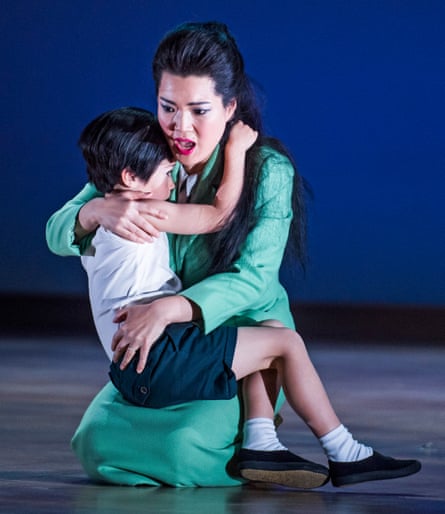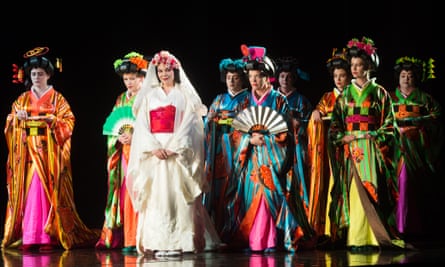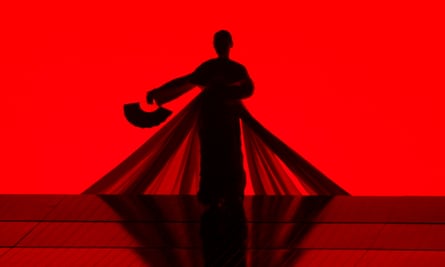Giacomo Puccini’s Madama Butterfly, premiered in Milan in 1904, is perhaps the most sordid story in the operatic canon – although there is no shortage of competition. Lieutenant BF Pinkerton, a naval officer from the USS Lincoln, is posted in Nagasaki. While there, aided by Goro, an unscrupulous Japanese marriage broker, he lures the fatherless, impoverished 15-year-old Butterfly into a temporary union. Thinking she is legally married, Butterfly abandons her Buddhist faith for Christianity and is renounced by her family and friends. Despite his strong attraction to her, and the warnings of the local US consul Sharpless, Pinkerton then deserts Butterfly, but tells her he will return to take her back to America.

Three years of waiting pass, during which time Butterfly secretly gives birth to his child with no one but her servant and companion Suzuki for support. When Pinkerton finally returns to Japan it is with his “real” American wife, Kate. On discovering the existence of his son they decide to take the child from Butterfly and back to America. Butterfly agrees to what she sees as a better life for her son and kills herself so he is not tormented in his adult years by his mother’s abandonment.
How do we as a modern audience of the #MeToo era experience this musical masterpiece, written by a white European man about the sexual exploitation and death of an Asian woman? How do we reconcile our enjoyment of this opera while acknowledging that it is an iconic example of Orientalism by a composer who never set foot in Japan? And how do we honour a desire to be true to the realities of the story when the Japanese characters are so often performed by western singers, an issue in an industry that must now confront its notable lack of diversity? None of these issues can be solved by one production – but never has it been more important for a director to grant Madama Butterfly a clear-eyed examination of the unpalatable realities of its libretto.
And what a libretto it is. Puccini went through five versions of the piece with his writers Giuseppe Giacosa and Luigi Illica until he achieved what we have today: a precise, ruthless exploration of how a near-powerless woman is bought and sold to a pleasure-seeking westerner. It is significant that Puccini, who could not speak English, first saw the play (by David Belasco) that inspired his libretto in London. The piece inflicts on Butterfly a patronising and infantilising cod-English dialogue that would be unacceptable on a modern stage and would have been alienating then.

Puccini’s lack of English meant he could transcend the indignity of her speech to see the inherent humanity of Butterfly. As a result, he defended her from any accusation of collusion in her own misfortune by creating an original Act 1 to flesh out the deliberate detail of her deception. Consequently, in Pinkerton they created one of the most morally bankrupt characters in opera – so unpleasant that Puccini had to be persuaded to sympathetically expand the role or risk having tenors reject the part as too small and seedy to perform.
He was determined that his audience should see the seduction and corruption of the innocent Butterfly as a conscious choice by Pinkerton. We hear that Butterfly is only 15 years old three times over, as she, Sharpless and Pinkerton drive the point home relentlessly. “The age of playthings,” Sharpless says. “And of sweetmeats,” replies Pinkerton shortly after toasting “the day on which I’ll wed in real marriage, a real wife from America”.
Faced with such an unequivocal libretto, it is a directorial duty not to be squeamish about presenting the story of this opera. In order to make as vivid as possible the disparity in the power dynamic between Pinkerton and Butterfly, the production I have created for Glyndebourne is set in the early 1950s. In the aftermath of the second world war, the War Brides Act allowed American servicemen who married abroad to bring their foreign wives home, thus enabling Japanese women to go to America in large numbers.

This meant lucrative business for marriage brokers such as our Goro, in whose bustling and obviously profitable office Act 1 is set. Butterfly’s wish to go to the US to start a new life with Pinkerton comes across particularly strongly when he is only one of many men who were facilitated by Japanese society to marry young local women. Some of these relationships had happy outcomes; some not. Our protagonists are part of a bigger story that validates and reinforces Pinkerton’s unthinking, sometimes callous behaviour.
We use original footage from 1950s newsreels showing Japanese women “learning to be an American wife” to illustrate how Butterfly might have been manipulated into imagining such a future. Watching these films and directing this story from the perspective of a privileged modern woman is sobering. It’s easy to be seduced into thinking of Madama Butterfly as a story from the past, a melodramatic opera that can be approached as a period piece. But this is a story that still manifests itself in many different reports in newspapers across the world today: the same pattern of western exploitation of vulnerable women can be seen in places such as Haiti.
And yet the opera is filled with moments of glorious, uninhibitedly romantic music, and this ecstasy is as much an integral part of this production as the dark subject matter. The near-mythic status this piece has in the operatic canon is due to its amazing combination of brutality and beauty, and that is both its strength and its weakness. This musical allure must never dull the unpleasantness of the story – it must be remembered that the first audience who heard Madama Butterfly in La Scala in 1904 ridiculed the piece, and shouted obscenities at the character of Butterfly.

As a modern composer who was as equally a man of the theatre as he was a man of music, Puccini refused to let the piece fail, even in the face of a disgusted first-night audience who greeted the onstage revelation of the child with what biographer Mosco Carner described as “an uproar of hisses, obscene sneers, [and] laughter”. They jeered at Butterfly’s perceived sexual licentiousness despite an unequivocal first act that establishes that she has understood herself to be legally married. This chaos continued in the theatre even during the stunning orchestral music accompanying Butterfly’s silent vigil for Pinkerton’s return. But despite the extremity of these reactions – which came as a shock for Puccini after a very successful dress rehearsal at which the orchestra had applauded him – the composer refused to dilute the brutality of the tale.
Therefore, to wallow in his orchestral beauty and ignore the hard truth of the libretto that inspired it is to disrespect both Puccini and the many real, anonymous Butterflies past and present who haunt every bar of this savage masterpiece. Puccini’s opera joins the long list of works of art that after years of unquestioning admiration are now problematic in our more enlightened modern times. But to continue to grapple with the story of Madama Butterfly, much as Puccini did himself, is to honour the empathetic impulse that inspired its creation: the strange and wonderful connection between an Italian opera composer and his imaginary geisha.
- Annilese Miskimmon’s production of Madama Butterfly is in rep at Glyndebourne until 18 July. It will be broadcast live in cinemas and streamed on the Glyndebourne website on 21 June.

Comments (…)
Sign in or create your Guardian account to join the discussion